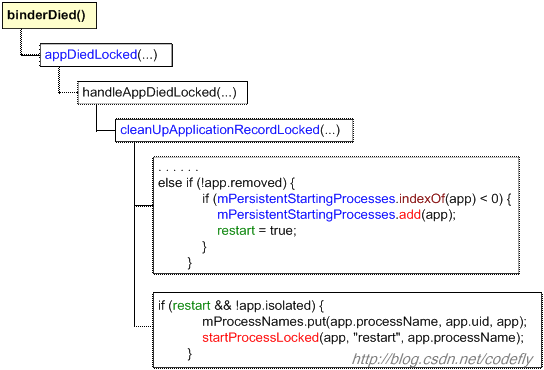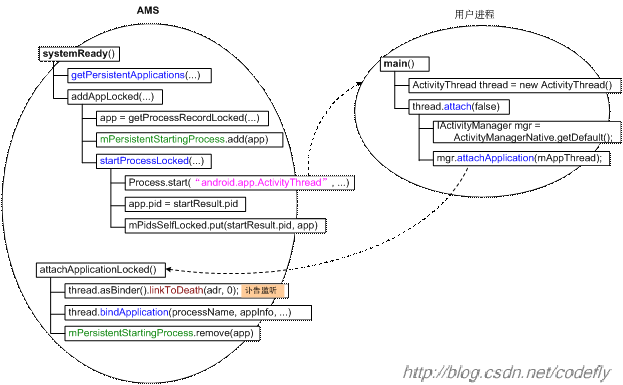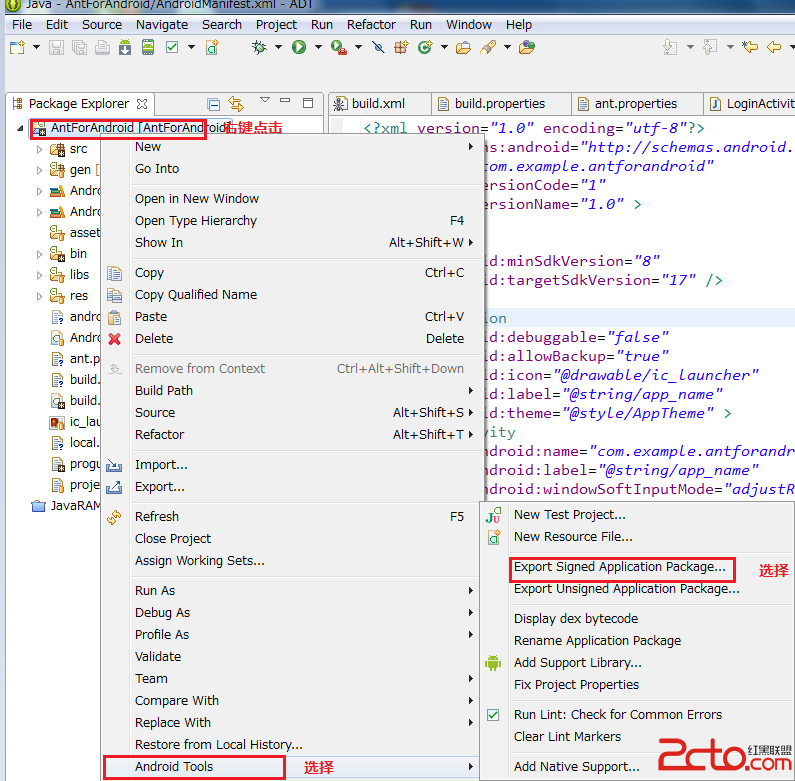編輯:關於Android編程
在Android系統中,有一種永久性應用。它們對應的AndroidManifest.xml文件裡,會將persistent屬性設為true,比如:
在系統啟動之時,AMS的systemReady()會加載所有persistent為true的應用。
public void systemReady(final Runnable goingCallback)
{
. . . . . .
. . . . . .
try{
List apps = AppGlobals.getPackageManager().
getPersistentApplications(STOCK_PM_FLAGS);
if(apps != null)
{
intN = apps.size();
inti;
for(i=0; i
其中的STOCK_PM_FLAGS的定義如下:
// The flags that are set for all calls we make to the package manager.
static final int STOCK_PM_FLAGS = PackageManager.GET_SHARED_LIBRARY_FILES;
上面代碼中的getPersistentApplications()函數的定義如下:
public List getPersistentApplications(int flags)
{
final ArrayList finalList = new ArrayList();
// reader
synchronized (mPackages)
{
final Iterator i = mPackages.values().iterator();
final int userId = UserId.getCallingUserId();
while (i.hasNext())
{
final PackageParser.Package p = i.next();
if (p.applicationInfo != null
&& (p.applicationInfo.flags & ApplicationInfo.FLAG_PERSISTENT) != 0
&& (!mSafeMode || isSystemApp(p)))
{
PackageSetting ps = mSettings.mPackages.get(p.packageName);
finalList.add(PackageParser.generateApplicationInfo(p, flags,
ps != null ? ps.getStopped(userId) : false,
ps != null ? ps.getEnabled(userId) : COMPONENT_ENABLED_STATE_DEFAULT,
userId));
}
}
}
return finalList;
}
在PKMS中,有一個記錄所有的程序包信息的哈希表(mPackages),每個表項中含有ApplicationInfo信息,該信息的flags(int型)數據中有一個專門的bit用於表示persistent。getPersistentApplications()函數會遍歷這張表,找出所有persistent包,並返回ArrayList。
從代碼裡可以看出,帶persistent標志的系統應用(即flags中設置了FLAG_SYSTEM)是一定會被選上的,但如果不是系統應用的話,則要進一步判斷當前是否處於“安全模式”,一旦處於安全模式,那麼就算應用設置了persistent屬性,也不會被選中。
隨後systemReady()開始遍歷選中的ApplicationInfo,並對包名不為“android”的結點執行addAppLocked()。addAppLocked()的代碼如下:
final ProcessRecord addAppLocked(ApplicationInfo info, boolean isolated) { ProcessRecord app; if (!isolated) { app = getProcessRecordLocked(info.processName, info.uid); } else { app = null; } if (app == null) { app = newProcessRecordLocked(null, info, null, isolated); mProcessNames.put(info.processName, app.uid, app); if (isolated) { mIsolatedProcesses.put(app.uid, app); } updateLruProcessLocked(app, true, true); } // This package really, really can not be stopped. try { AppGlobals.getPackageManager().setPackageStoppedState( info.packageName, false, UserId.getUserId(app.uid)); } catch (RemoteException e) { } catch (IllegalArgumentException e) { Slog.w(TAG, Failed trying to unstop package + info.packageName + : + e); } if ((info.flags&(ApplicationInfo.FLAG_SYSTEM|ApplicationInfo.FLAG_PERSISTENT)) == (ApplicationInfo.FLAG_SYSTEM|ApplicationInfo.FLAG_PERSISTENT)) { app.persistent = true; app.maxAdj = ProcessList.PERSISTENT_PROC_ADJ; } if (app.thread == null && mPersistentStartingProcesses.indexOf(app) < 0) { mPersistentStartingProcesses.add(app); startProcessLocked(app, added application, app.processName); } return app; }
? 在AMS中,所謂的“add App”主要是指“添加一個與App進程對應的ProcessRecord節點”。當然,如果該節點已經添加過了,那麼是不會重復添加的。在添加節點的動作完成以後,addAppLocked()還會檢查App進程是否已經啟動好了,如果尚未開始啟動,此時就會調用startProcessLocked()啟動這個進程。既然addAppLocked()試圖確認App“正在正常運作”或者“將被正常啟動”,那麼其對應的package就不可能處於stopped狀態,這就是上面代碼調用setPackageStoppedState(...,false,...)的意思。
現在,我們就清楚了,那些persistent屬性為true的應用,基本上都是在系統啟動伊始就啟動起來的。
因為啟動進程的過程是異步的,所以我們需要一個緩沖列表(即上面代碼中的mPersistentStartingProcesses列表)來記錄那些“正處於啟動狀態,而又沒有啟動完畢的”ProcessRecord結點。一旦目標進程啟動完畢後,目標進程會attach系統,於是走到AMS的attachApplicationLocked(),在這個函數裡,會把目標進程對應的ProcessRecord結點從mPersistentStartingProcesses緩沖列表裡刪除。
private final boolean attachApplicationLocked(IApplicationThread thread, intpid) {
// Find the application record that is being attached... either via
// the pid if we are running in multiple processes, or just pull the
// next app record if we are emulating process with anonymous threads.
ProcessRecord app;
. . . . . .
thread.asBinder().linkToDeath(adr,0);
. . . . . .
thread.bindApplication(processName, appInfo, providers,
app.instrumentationClass, profileFile, profileFd, profileAutoStop,
app.instrumentationArguments, app.instrumentationWatcher, testMode,
enableOpenGlTrace, isRestrictedBackupMode || !normalMode,
app.persistent,
newConfiguration(mConfiguration), app.compat,
getCommonServicesLocked(),
mCoreSettingsObserver.getCoreSettingsLocked());
. . . . . .
. . . . . .
// Remove this record from the list of starting applications.
mPersistentStartingProcesses.remove(app);
. . . . . .
?
2 如何保證應用的持久性(persistent)
我們知道,persistent一詞的意思是“持久”,那麼persistent應用的意思又是什麼呢?簡單地說,這種應用會頑固地運行於系統之中,從系統一啟動,一直到系統關機。
為了保證這種持久性,persistent應用必須能夠在異常出現時,自動重新啟動。在Android裡是這樣實現的。每個ActivityThread中會有一個專門和AMS通信的binder實體——final ApplicationThread mAppThread。這個實體在AMS中對應的代理接口為IApplicationThread。
當AMS執行到attachApplicationLocked()時,會針對目標用戶進程的IApplicationThread接口,注冊一個binder訃告監聽器,一旦日後用戶進程意外掛掉,AMS就能在第一時間感知到,並采取相應的措施。如果AMS發現意外掛掉的應用是persistent的,它會嘗試重新啟動這個應用。
注冊訃告監聽器的代碼如下:
AppDeathRecipient adr = new AppDeathRecipient(app, pid, thread);
thread.asBinder().linkToDeath(adr,0);
app.deathRecipient = adr;
其中的thread就是IApplicationThread代理。
AppDeathRecipient的定義如下:
private final class AppDeathRecipient implementsIBinder.DeathRecipient
{
final ProcessRecord mApp;
final int mPid;
final IApplicationThread mAppThread;
AppDeathRecipient(ProcessRecord app, intpid,
IApplicationThread thread)
{
if(localLOGV)
Slog.v(TAG,New death recipient + this
+ for thread + thread.asBinder());
mApp = app;
mPid = pid;
mAppThread = thread;
}
publicvoidbinderDied()
{
if(localLOGV)
Slog.v(TAG,Death received in + this
+ for thread + mAppThread.asBinder());
synchronized(ActivityManagerService.this)
{
appDiedLocked(mApp, mPid, mAppThread);
}
}
}
當其監聽的binder實體死亡時,系統會回調AppDeathRecipient的binderDied()。這個回調函數會輾轉重啟persistent應用,調用關系如下:

一般情況下,當一個應用進程掛掉後,AMS當然會清理掉其對應的ProcessRecord,這就是cleanUpApplicationRecordLocked()的主要工作。然而,對於persistent應用,cleanUpApplicationRecordLocked()會嘗試再次啟動對應的應用進程。代碼截選如下:
private final void cleanUpApplicationRecordLocked(ProcessRecord app,
boolean restarting,
boolean allowRestart,int index)
{
. . . . . .
. . . . . .
if (!app.persistent || app.isolated)
{
. . . . . .
mProcessNames.remove(app.processName, app.uid);
mIsolatedProcesses.remove(app.uid);
. . . . . .
}
else if(!app.removed)
{
if(mPersistentStartingProcesses.indexOf(app) < 0) {
mPersistentStartingProcesses.add(app);
restart = true;
}
}
. . . . . .
. . . . . .
if (restart && !app.isolated)
{
mProcessNames.put(app.processName, app.uid, app);
startProcessLocked(app,restart, app.processName);
}
else if(app.pid > 0&& app.pid != MY_PID)
{
. . . . . .
}
. . . . . .
}
現在我們可以畫一張關於“啟動persistent應用”的示意圖:

3 補充知識點
3.1 persistent應用可以在系統未准備好時啟動
在AMS中,有一個isAllowedWhileBooting()函數,其代碼如下:
boolean isAllowedWhileBooting(ApplicationInfo ai)
{
return (ai.flags & ApplicationInfo.FLAG_PERSISTENT) != 0;
}
從這個函數可以看到,將persistent屬性設為true的應用,是允許在boot的過程中啟動的。我們可以查看前文提到的startProcessLocked()函數:
final ProcessRecord startProcessLocked(String processName,
ApplicationInfo info, boolean knownToBeDead,
int intentFlags,
String hostingType, ComponentName hostingName,
boolean allowWhileBooting,
boolean isolated)
{
ProcessRecord app;
if(!isolated)
{
app = getProcessRecordLocked(processName, info.uid);
}
else
{
// If this is an isolated process, it can't re-use an existing process.
app = null;
}
. . . . . .
. . . . . .
if(!mProcessesReady
&& !isAllowedWhileBooting(info)
&& !allowWhileBooting) {
if(!mProcessesOnHold.contains(app)) {
mProcessesOnHold.add(app);
}
if(DEBUG_PROCESSES) Slog.v(TAG, System not ready, putting on hold: + app);
return app;
}
startProcessLocked(app, hostingType, hostingNameStr);
return (app.pid != 0) ? app : null;
}
?
其中的最後幾句可以改寫為以下更易理解的形式:
if (mProcessesReady || isAllowedWhileBooting(info) || allowWhileBooting)
{
startProcessLocked(app, hostingType, hostingNameStr);
return (app.pid != 0) ? app : null;
}
else
{
. . . . . .
returnapp;
}
?
也就是說,當系統已經處於以下幾種情況時,多參數的startProcessLocked()會進一步調用另一個只有三個參數的startProcessLocked():
1)系統已經處於ready狀態;
2)想要啟動persistent應用;
3)參數中明確指定可以在boot過程中啟動應用。
補充說一下,一般情況下,當AMS調用startProcessLocked()時,傳入的allowWhileBooting參數都為false。比如說,當系統需要啟動“某個content provider或者某個service或者某個特定activity”時,此時傳給startProcessLocked()的allowWhileBooting參數是寫死為false的。只有一種特殊情況下會在該參數中傳入true,那就是當系統發出的廣播intent中攜帶有Intent.FLAG_RECEIVER_BOOT_UPGRADE標記時,此時允許在系統未ready時,啟動接受廣播的目標進程。
 Android API Guides---OpenGL ES
Android API Guides---OpenGL ES
OpenGL ESAndroid包括高性能2D和3D圖形開放圖形庫(OpenGL?的),具體而言,OpenGL ES的API支持。 OpenGL是一個跨平台的圖形API,
 Android通過反射和注解簡化代碼編寫(一)
Android通過反射和注解簡化代碼編寫(一)
隨著應用復雜度增加,後期的應用更傾向於模塊化、插件化來盡量減少主程序的容量,對此有幾種方法來解決:1.使用so來封裝共同模塊,通過加載庫的形式實現代碼共享2.使用jar形
 Android 生成keystore,兩種方式
Android 生成keystore,兩種方式
一、eclipse 中生成android keystore 建立任意一個android項目(例如:AntForAndroid) Export Signed Appl
 Android資源圖片讀取機制
Android資源圖片讀取機制
在新建一個Android項目時,在res目錄下會自動生成幾個drawable文件夾,drawable-ldpi,drawable-mdpi,drawable-hdpi,一